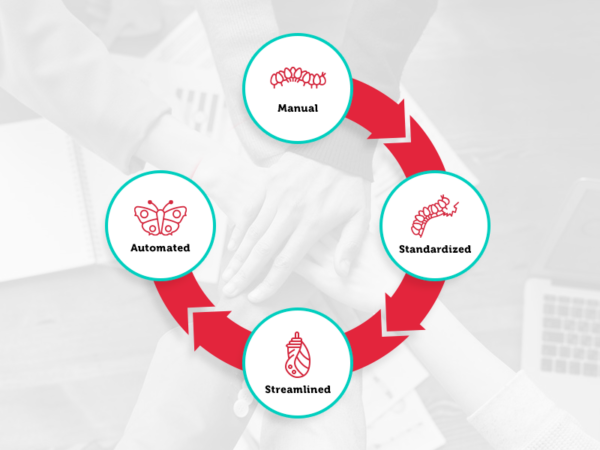I’ve spoken with finance executives across a wide range of industries and company sizes, including several who, to weather the storm, have furloughed or permanently laid off four of every five people on their finance and accounting teams. While transaction volume for these departments might be down, they still essentially face the same challenges: managing spend, collecting revenue, reporting results, and forecasting what’s next.
Depending on the shape of the economic recovery, it may be years before some industries return to full employment, and I’d venture to say those hit hardest may never see back-office staffing reach their pre-pandemic levels. So, now what?
Companies with cash on their balance sheets—or available through recapitalization—now have an opportunity to reinvent themselves.
Turn to Nature for Insight
Bears, reptiles, and other of nature’s wonders hibernate when stressed. They put on extra weight, then retreat to a safe place to ride out the elements until things are safer. When they emerge, they’re leaner, but not all that different from when they entered their lair. In fact, it takes time for them to rebuild their strength, with muscles atrophying after months of non-use.
On the other hand, if we look at the butterfly, we see a radical transformation.
The butterfly eats a hearty diet, hunkers down building a cocoon, and prepares for a fundamentally different future, as the earthbound creature prepares for a life in the sky. Similarly, companies with cash on their balance sheets—or available through recapitalization—now have an opportunity to reinvent themselves during the COVID-19 pandemic.
If you look at the maturity model of finance organizations, you see parallels to the butterfly’s lifecycle. In the early stages, organizational processes are manual. The caterpillar eats solid food and is earth-bound. As an organization matures, it standardizes, streamlines, and automates. The butterfly changes its diet, goes through a complete physical metamorphosis, and takes flight.

If, as industry analysts are predicting, businesses that survive the pandemic are destined to have fewer people to do the same amount of work, then they’ll have to change the nature of how they work. While many of us are similarly sequestered, we can take a hard look at our processes, re-engineer them for scalability and resiliency, and redesign them to meet the demands of the post-pandemic world. Forward-looking financial executives are using this time to plan their metamorphosis, using the pandemic as a catalyst to drive their organizations forward.
Some might question the timing, with many companies taking on huge losses. But from my perspective, the time is right. Investors have already absorbed pandemic-related losses. Investments in finance transformation can be relatively minor. So why not make the move now?
Start with Processes, Technology, and People
The opportunity and investment requirements will, of course, vary from organization to organization. But three critical steps should be part of any transformation initiative:
1. Optimize your processes.
2. Take advantage of technology, automating what you can.
3. Manage change and get your people on board.
Some firms are struggling with their revenue cycle—how quickly and efficiently they can turn a customer order into cash. For them, a deep dive into their order-to-cash process might be the right place to begin. For others, the procure-to-pay process might be lagging. They can drive down the cost of procurement and wasted effort through process overhauls, strategic sourcing, systems upgrades, vendor consolidation, and automation.
If you’re relying on paper evidence and approvals, working in a distributed environment is probably having a significant impact on your team’s productivity … and their morale.
In some organizations, there may be no better place to start than in the record-to-report (R2R) process, which requires accounting professionals to perform the recurring tasks of closing their books and reporting results. As I pointed out in Closing the Books on the First Financial Close of the Pandemic, inefficiencies are common in R2R, despite the fact that every company performs the process (and most do it every month!). Only about half of mid-size and large organizations have adopted close optimization tools such as BlackLine, and even those who have implemented them aren’t taking full advantage.
If you’re relying on paper evidence and approvals, working in a distributed environment is probably having a significant impact on your team’s productivity—and morale. Firms that haven’t automated their R2R process saddle their workforce with manual effort and lost efficiency that just isn’t necessary in today’s business environment.
Are your accountants manually extracting data from subledgers? If so, start there. If your systems enable automated reporting, implement it—doing so will make your accounting team more productive. If your systems can’t automatically extract the data you need, consider alternatives such as robotic process automation (RPA) to offload this task to a “digital worker.”
We have prebuilt solutions to extract transactional and subledger data—scheduled or on-demand—so that your team isn’t waiting for the data they need. And BlackLine has a set of enterprise resource planning (ERP) connectors to automate data exchange between ERPs and their platform.
If much of your financial close is performed in Excel and communicated through endless email chains, there’s a better way. Using a purpose-built cloud platform to facilitate the close process is a godsend to teams that previously lacked a central system for housing policies, procedures, transactions, approvals, and evidence. That’s a great first step. But combine this central system of record with R2R process optimization and automation, and now you’re really looking at an R2R metamorphosis.
Step 1: Optimize Financial Close Processes
So, where do we look to optimize processes? That depends are how you’re operating today. We advise firms to take a hard look at each of the tasks they perform during the close and ask a few pointed questions:
- Is this task essential? This seems basic, but you’d be surprised how many reports or reconciliations are performed that no one uses any longer—they’ve just been chiseled into the rules of an archaic process.
- Can this task be performed outside of the close? We see lots of tasks—accruals are a great example—that some firms perform during crunch time that could easily be automated or moved to a different time of the month.
- Are interdependencies known, logical, and necessary? How do you identify and eliminate bottlenecks?

Step 2: Implement Automation Technology
Centralizing visibility and availability of relevant documents is obviously a key benefit for BlackLine users who are working in a distributed environment, but this is just the tip of the iceberg. There are plenty of other reasons to consider investing in BlackLine.
Task management: BlackLine enables administrators to assign tasks associated with the financial close to contributors. Better yet, the system provides real-time insight into progress and completion, providing vital insight and empowering management to reallocate resources when necessary.
Integrated source of truth: Use BlackLine to incorporate data from disparate banking, expense, and revenue platforms into a single system.
Controls: BlackLine manages and maintains records associated with the preparation and approval of records, ensuring that controls are effective, and duties are segregated.
Connectivity with auditors: Even firms that have a streamlined close process can struggle to provide auditors with the data they need—unless you use BlackLine to facilitate access.
Automation: It’s possible to drastically reduce the number of manual journal entries. In fact, BlackLine reports that their users have reduced time spent performing reconciliations by more than 50%. And, using tools such as ReconBotz from our partner WonderBotz, you can virtually eliminate manual reconciliations.
Step 3: Manage the ‘People Part’ of Change and Drive Adoption
Re-engineering processes and introducing innovative technologies are important steps, but they’re wasted investments if your team doesn’t fully adopt them. It’s widely accepted that more than half of transformation efforts fall short of expectations—or fail altogether—and people-related issues account for 7 of the top 10 reasons projects fail.1
Too often, this is the result of “silver bullet syndrome,” thinking a new ERP system or application will solve process inefficiencies or magically deliver productivity gains. For any big initiative to succeed, you have to plan for the “people part” of transformation.
First, you need to ensure the platform and processes are harmonized to meet the demands of your business. Second, you have to ensure your team embraces the solution and understands how to use it to its full potential.
That’s a critical element of our Return on Change™ framework, which accounts for the human impacts of change as well as process and technology issues, enabling you to minimize the typical performance dip by 50% on average.
I truly believe that process optimization and technology adoption are critical to the survival of many firms’ finance and accounting functions. The number of F&A grads is dropping, baby boomers are retiring, and Gen Xers aren’t far behind. Those remaining are seeking organizations that have embraced process redesign and modern technology to eliminate mundane work, so they can focus on delivering real value.
Despite pandemic-related furloughs and layoffs, I expect the “war on F&A talent” to continue for years to come. Firms need to attract the best and brightest—or change their human capital model altogether—to compete for top performers.
You may be asking, “Can we afford the investment to optimize and transform my finance function right now?” The better question might be, “How can you afford not to reinvent yourselves?”


